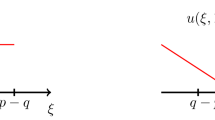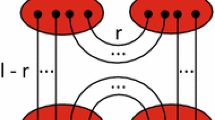Abstract
We consider all totally asymmetric simple exclusion processes (TASEPs) whose transition probabilities are given by the Schütz-type formulas and which jump with homogeneous rates. We show that the multi-point distribution of particle positions and the KPZ scaling are described using the probability generating function of the rightmost particle’s jump. For all TASEPs satisfying certain assumptions, we also prove the pointwise convergence of the kernels appearing in the joint distribution of particle positions to those appearing in the KPZ fixed point formula. Our result generalizes the result of Matetski, Quastel, and Remenik [18] in the sense that we provide the KPZ fixed point formulation for a class of TASEPs, instead of for one specific TASEP.
Similar content being viewed by others
Availability of data and materials
Data sharing not applicable to this article as no datasets were generated or analysed during the current study
References
Arai, Y.: The KPZ fixed point for discrete time TASEPs. J. Phys. A 53, 415202 (2020)
Baik, J., Rains, E.M.: Algebraic aspects of increasing subsequences. Duke Math. J. 109, 1–65 (2001)
Baik, J., Rains, E.M.: The asymptotics of monotone subsequences of involutions. Duke Math. J. 109, 205–281 (2001)
Billingsley, P.: Convergence of probability measures, Wiley Series in Probability and Statistics. Wiley, New York (1999)
Bisi, E., Liao, Y., Saenz, A., Zygouras, N.: Non-intersecting path constructions for TASEP with inhomogeneous rates and the KPZ fixed point. Comm. Math. Phys. 402, 285–333 (2023)
Borodin, A., Ferrari, P.L.: Large time asymptotics of growth models on space-like paths I: PushASEP. Electron. J. Probab. 13, 1380–1418 (2008)
Borodin, A., Ferrari, P.L.: Anisotropic Growth of Random Surfaces in \(2 + 1\) Dimensions. Comm. Math. Phys. 325, 603–684 (2014)
Borodin, A., Ferrari, P.L., Prähofer, M.: Fluctuation in the discrete TASEP with periodic initial configurations and the \({\rm Airy}_1\) process. Int. Math. Res. Pap. IMRP 2007, 1–47 (2007)
Borodin, A., Ferrari, P.L., Prähofer, M., Sasamoto, T.: Fluctuation properties of the TASEP with periodic initial configuration. J. Stat. Phys. 129, 1055–1080 (2007)
Borodin, A., Ferrari, P.L., Sasamoto, T.: Large time asymptotics of growth models on space-like paths II: PNG and parallel TASEP. Comm. Math. Phys. 283, 417–449 (2008)
Corwin, I., Hammond, A., Hegde, M., Matetski, K.: Exceptional times when the KPZ fixed point violates Johansson’s conjecture on maximizer uniqueness. Electron. J. Probab. 28, 1–81 (2023)
Dieker, A.B., Warren, J.: Determinantal transition kernels for some interacting particles on the line. Ann. Inst. Henri Poincaré Probab. Stat. 44, 1162–1172 (2008)
Johansson, K.: Shape fluctuations and random matrices. Comm. Math. Phys. 209, 437–476 (2000)
Johansson, K.: Discrete polynuclear growth and determinantal processes. Comm. Math. Phys. 242, 277–329 (2003)
Kardar, M., Parisi, G., Zhang, Y.-C.: Dynamic scaling of growing interfaces. Phys. Rev. Lett. 56, 889–892 (1986)
Matetski, K., Remenik, D.: Exact solution of TASEP and variants with inhomogeneous speeds and memory lengths, arXiv:2301.13739, (2023)
Matetski, K., Remenik, D.: TASEP and generalizations: Method for exact solution. Probab. Theory Related Fields 185, 615–698 (2023)
Matetski, K., Quastel, J., Remenik, D.: The KPZ fixed point. Acta Math. 227, 115–203 (2021)
Nica, M., Quastel, J., Remenik, D.: One-sided reflected Brownian motions and the KPZ fixed point. Forum Math. Sigma 8, 1–16 (2020)
Prähofer, M., Spohn, H.: Universal distributions for growth processes in 1 + 1 dimensions and random matrices. Phys. Rev. Lett. 84, 4882–4885 (2000)
Prähofer, M., Spohn, H.: Scale Invariance of the PNG Droplet and the Airy Process. J. Stat. Phys. 108, 1071–1106 (2002)
Quastel, J., Matetski, K.: From the totally asymmetric simple exclusion process to the KPZ fixed point. IAS/Park City Math. Ser., Providence, RI: Amer. Math. Soc., 26, 251–301 (2019)
Quastel, J., Sarkar, S.: Convergence of exclusion processes and the KPZ equation to the KPZ fixed point. J. Amer. Math. Soc. 36, 251–289 (2023)
Rákos, A., Schütz, G.M.: Current distribution and random matrix ensembles for an integrable asymmetric fragmentation process. J. Stat. Phys. 118, 511–530 (2005)
Sarkar, S., Virág, B.: Brownian absolute continuity of the KPZ fixed point with arbitrary initial condition. Ann. Probab. 49, 1718–1737 (2021)
Sasamoto, T.: Spatial correlations of the 1D KPZ surface on a flat substrate. J. Phys. A 38, 549–556 (2005)
Schütz, G.M.: Exact solution of the master equation for the asymmetric exclusion process. J. Stat. Phys. 88, 427–445 (1997)
Simon, B.: Trace ideals and their applications, Mathematical Surveys and Monographs, Providence, RI: Amer. Math. Soc. 120, (2005)
Spitzer, F.: Interaction of Markov processes. Adv. Math. 5, 246–290 (1970)
Spohn, H.: KPZ scaling theory and the semi-discrete directed polymer model, Random matrix theory, interacting particle systems, and integrable systems, 65, Math. Sci. Res. Inst. Publ. Cambridge Univ. Press, 483–493 (2014)
Tracy, C.A., Widom, H.: Level-spacing distributions and the Airy kernel. Comm. Math. Phys. 159, 151–174 (1994)
Tracy, C.A., Widom, H.: On orthogonal and symplectic matrix ensembles. Comm. Math. Phys. 177, 727–754 (1996)
Warren, J., Windridge, P.: Some Examples of Dynamics for Gelfand-Tsetlin Patterns. Electron. J. Probab. 14, 1745–1769 (2009)
Author information
Authors and Affiliations
Corresponding author
Ethics declarations
Conflict of interest
The authors have no conflicts of interest directly relevant to the content of this article.
Additional information
Publisher's Note
Springer Nature remains neutral with regard to jurisdictional claims in published maps and institutional affiliations.
Appendices
Appendix A The KPZ fixed point for the continuous time TASEP with jump rate \(\beta \)
In this section, we use our method to show that the KPZ fixed point is obtained in the continuous time TASEP with jump rate \(\beta \in (0, \infty )\). From (2.3) and Proposition 2, we get
Besides, by (2.25), we have
If \(\gamma (w)\) satisfies Assumption 5 and 7, we can show Theorem 8 using Theorem 4 and Proposition 9. Therefore, we prove that \(\gamma (w)\) satisfies Assumption 5 and Assumption 7.
First, we show that \(\gamma (w)\) satisfies Assumption 5. Calculating the derivatives of \(\gamma (w)\) up to the third order, we get
Substituting \(w=0\) in (A1) gives
Thus, we obtain
Next we prove that \(\gamma (w)\) satisfies Assumption 7. By (2.38), (2.39), (2.40), and (A2), we have
Note that \(\log (1+x)< x\) for \(x\in (-1, \infty )\setminus \{0\}\). For \(\theta \in [-\pi , -\frac{\pi }{3})\cup (\frac{\pi }{3}, \pi ]\), by (A3), we obtain
and
This completes the proof.
Appendix B The KPZ fixed point for the discrete time Bernoulli TASEP with sequential update
In this section, we use our method to prove that the KPZ fixed point is derived in the discrete time Bernoulli TASEP with sequential update. This proof can be shown in a similar manner to Appendix A. By (2.4) and Proposition 2, we have
Furthermore, by (2.25), we get
If \(\gamma (w)\) satisfies Assumption 5 and Assumption 7, we can prove Theorem 8 using Theorem 4 and Proposition 9. Thus, we show that \(\gamma (w)\) satisfies Assumption 5 and Assumption 7.
First, we prove that \(\gamma (w)\) satisfies Assumption 5. Calculating the derivatives of \(\gamma (w)\) up to the third order, we obtain
Substituting \(w=0\) in (B1) gives
Therefore, we get
Next we show that \(\gamma (w)\) satisfies Assumption 7. By (2.38), (2.39), (2.40), and (B2), we obtain
Note that \(\log (1+x)< x\) for \(x\in (-1, \infty )\setminus \{0\}\). For \(\theta \in [-\pi , -\frac{\pi }{3})\cup (\frac{\pi }{3}, \pi ]\), by (B3), we have
and
Note that we used the expression transform
This completes the proof.
Appendix C The KPZ fixed point for the discrete time geometric TASEP with parallel update
In this section, we use our method to show that the KPZ fixed point is obtained in the discrete time geometric TASEP with parallel update. This proof can be proved in a similar manner to Appendix A and Appendix B. By (2.7) and Proposition 2, we obtain
Moreover, by (2.25), we have
If \(\gamma (w)\) satisfies Assumption 5 and Assumption 7, we can show Theorem 8 using Theorem 4 and Proposition 9. Therefore, we prove that \(\gamma (w)\) satisfies Assumption 5 and Assumption 7.
First, we show that \(\gamma (w)\) satisfies Assumption 5. Calculating the derivatives of \(\gamma (w)\) up to the third order, we obtain
Substituting \(w=0\) in (C1) gives
Thus, we have
Next we prove that \(\gamma (w)\) satisfies Assumption 7. By (2.38), (2.39), (2.40), and (C2), we obtain
We remark that \(\log (1+x)< x\) for \(x\in (-1, \infty )\setminus \{0\}\). For \(\theta \in [-\pi , -\frac{\pi }{3})\cup (\frac{\pi }{3}, \pi ]\), by (C3), we get
and
Note that we used a transformation similar to (B4). This completes the proof.
Rights and permissions
Springer Nature or its licensor (e.g. a society or other partner) holds exclusive rights to this article under a publishing agreement with the author(s) or other rightsholder(s); author self-archiving of the accepted manuscript version of this article is solely governed by the terms of such publishing agreement and applicable law.
About this article
Cite this article
Arai, Y. On the KPZ Scaling and the KPZ Fixed Point for TASEP. Math Phys Anal Geom 27, 4 (2024). https://doi.org/10.1007/s11040-024-09475-y
Received:
Accepted:
Published:
DOI: https://doi.org/10.1007/s11040-024-09475-y




